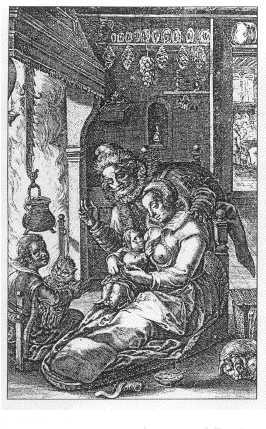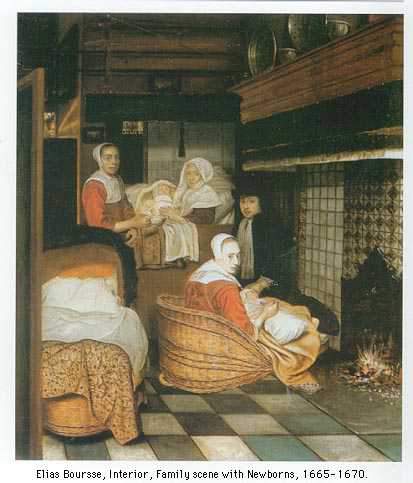Feeding Breast milk / Mothers milk
 Breast
milk was considered the only proper, healthy - and for that matter the only
logically available milk for babies in Vermeer's day. In the Dutch Republic,
mothers would normally breast feed their own babies - as opposed to the current
fashion for women in higher circles in southern European countries, who regularly
farmed out babies to be breast fed by hired women elsewhere in town or out of
town.
Breast
milk was considered the only proper, healthy - and for that matter the only
logically available milk for babies in Vermeer's day. In the Dutch Republic,
mothers would normally breast feed their own babies - as opposed to the current
fashion for women in higher circles in southern European countries, who regularly
farmed out babies to be breast fed by hired women elsewhere in town or out of
town.
If in Dutch households the baby did not suck strongly enough, there was a serious
danger of mother's milk production stopping alltogether. In order to safeguard
against that, there was a special class of elderly ladies available - who could
be hired to suck mothers milk. One such elderly lady by the name of Maijcke
van den Broucke lived in Haarlem, and she stated to a notary public that this
fresh human dairy product tasted very nice indeed.
The source does not mention whether the pre-sucked milk was transferred to
the babies mouth right away or spit out into bottles for the use of babies.
If so, it would logically be put in a pewter feeding bottle.
Alternatively, goats milk coud be used to feed babies.
Source: Mike Dash, Batavia's Graveyard, Crown
publishers, New York, 2001. I read the dutch edition De ondergang van de
Batavia, het ware verhaal, p. 132
When Reynier Bolnes and Maria Thins separated in Gouda amid strife their goods
were split with the help of lawyers - between the two parties, Maria Thins and
Catharina Bolnes shipped all of their clothes to Delft. There was also a group
of paintings, which proved to be interesting as some most probably reappeared
as paintings-within-Vermeer-paintings. On the Vermeer painting Music Lesson we also see a history scene
of Roman Charity, featuring Pero, daughter of Cimon who offers her
breast to the imprisoned Cimon who is condemned to die of
starvation.
Read about potty
training.

This page forms part of a large encyclopedic site on Delft. Research by Drs. Kees Kaldenbach (email). A
full presentation is on view at johannesvermeer.info.
Launched December, 2002; Last update March 1, 2017.
Back to the Welcome page: click Welcome.
 Breast
milk was considered the only proper, healthy - and for that matter the only
logically available milk for babies in Vermeer's day. In the Dutch Republic,
mothers would normally breast feed their own babies - as opposed to the current
fashion for women in higher circles in southern European countries, who regularly
farmed out babies to be breast fed by hired women elsewhere in town or out of
town.
Breast
milk was considered the only proper, healthy - and for that matter the only
logically available milk for babies in Vermeer's day. In the Dutch Republic,
mothers would normally breast feed their own babies - as opposed to the current
fashion for women in higher circles in southern European countries, who regularly
farmed out babies to be breast fed by hired women elsewhere in town or out of
town.